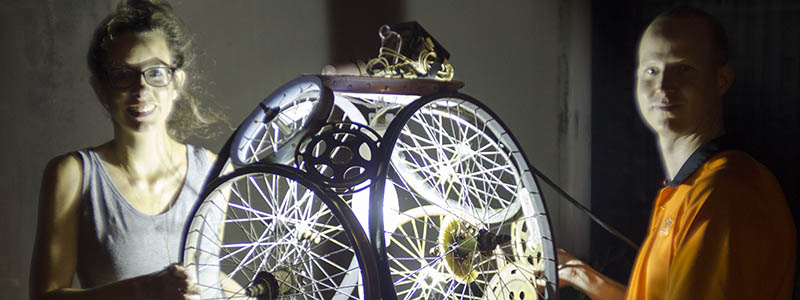Street fighters
Tulsa artists on the state of street art, the rules of engagement, and the line between good and evil
(page 2 of 4)
Illuminate the problem
Jessica Brent, a Transportation Planner with INCOG, and Zachary Carpenter, an Electrical Engineer, live in the Founder’s District, the area north of Downtown that consists of Brady Heights, Country Club Gardens, Crosbie Heights, and Owen Park. The main thoroughfare into downtown for Brent, Carpenter, and their neighbors is the I-244 overpass at Main Street, which is dark at night and even a little creepy when seen from under the warm, neon glow of Cain¹s Ballroom. The city vows to brighten up the area, eventually. But these two decided not to sit around and wait.
Jessica Brent: The piece that we created was meant to be a solution to a problem that we saw in our neighborhood north of downtown. We like to walk and bike into the Brady District and downtown, and Main Street is the primary corridor accessible to us, and it’s poorly lit and surrounded by a wasteland.
Zachary Carpenter: If this area was lit well, it might encourage more people to park over here and get a better sense of safety for this area.
JB: So we decided to take matters into our own hands.
ZC: We were both members of the Founders’ District, and [another] member knew someone at Tulsa Hub and got [bike] parts for us and I built a chandelier in my garage one evening. That was the prototype, just proof of concept, and we never really did anything with it then. Jessica got us started again and we got some more parts and built a bigger fixture. Those were the two fixtures that were installed down here when we did the unveiling.
JB: Zach was trying to get permission through the City, and they were like, “Who are you? You wanna install lights under a bridge? I don’t think so.” So I stepped in. I’m a Transportation Planner, I have connections with the transportation folks with the City, and they were more receptive to me. So we were able to do a test project. It only stayed up one night.
ZC: They were supportive in the end, just to see how people liked it.
JB: We hung it under the I-244 overpass at Main Street. Our goal wasn’t for that to be the solution, but just to demonstrate the need for lighting and the possibility for a creative solution.
ZC: It’s just a real get-your-hands-dirty way of showing the City that you care about something enough to actually do it and put it up and let people see it and comment on it.
JB: We ran the power from Cain’s Ballroom. They had been on the news recently saying they want lights on under the bridge.
We coincided it with First Friday Art Crawl, and there was also a show at Cain’s, so there were just a ton of people down there, a lot of people got to see it.
ZC: All the comments were positive. They like light under the bridge, they like it to be safer, they like the artistic fixtures. We haven’t heard anything from the City.
JB: The neighbors that walked down from the neighborhood felt a sense of relief. They were walking down in the daylight to go to a baseball game and later in the dark they knew this light would be there for them. A lot of people were really enchanted by it and were taking pictures of it, and saying, “What is this thing?” That’s what we wanted, to get people interested in it.
ZC: I suggested a more permanent installation that they, at minimum, have on nights that things are going on down here, but a better solution would be to have it on from dark to two a.m. every night. The City says it may be a year or so until they can get permanent lighting installed, but they’ve been saying that for years. Best-case scenario: let us more permanently install [our fixtures] until they [the City] can get the funding to do the lighting like they want to do it. A perfect example of that is on the Elgin bridge. It’s all-new LED lighting, but it’s very costly. This cost us zero. It’s all donated parts. If all the electrical portions were bought, it would still only be a few hundred dollars per fixture. Basically, all we need is watertight conduit and enclosures. But it is a massive bridge, so that’s a lot of wire, conduit, and man-hours to get that in.
JB: I’m working with the Brady Arts District Business Association to see if there’s any sort of financial support for a more permanent installation. If there’s not, I’d like to try crowd funding.
ZC: [We want to show] that people who care about these areas and the safety of these areas can do something about it and they can organize and get something done quickly.
JB: Test your ideas. We’re always looking for creative solutions to make it a better place.



.jpg)
.jpg)
